FUJI GFX 100 vs. FUJI GFX 50R vs. LEICA SL2
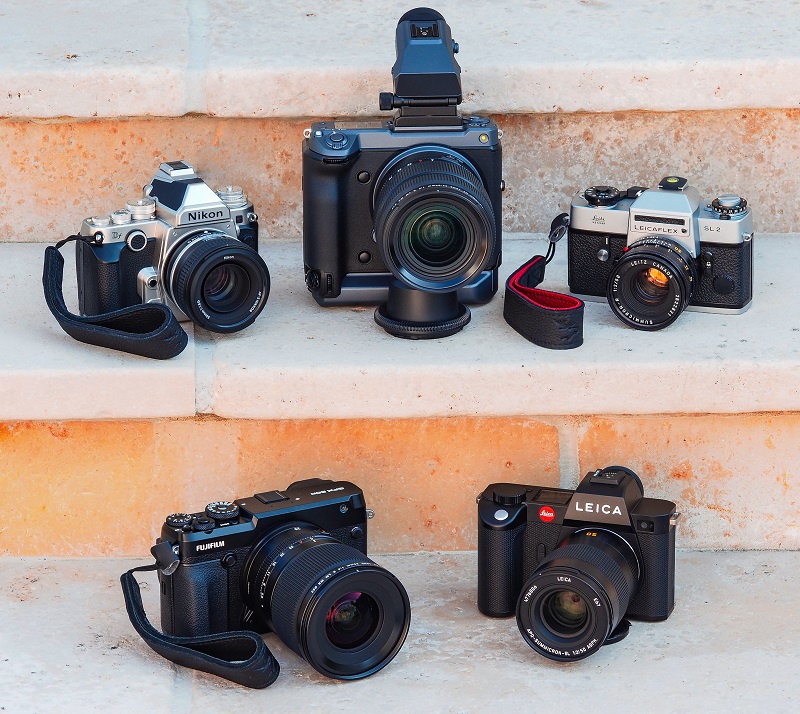
HOW IT CAME TO THIS TEST
I had a CANON photo equipment until 2016. Then in 2017 I entered the mirrorless world with the PANASONIC G9, followed by my OLYMPUS PEN F and a SONY A7 RIII.
In search of perfection, I traded in my SONY for the FUJI GFX 50S in 2018, which I then replaced in turn with the FUJI GFX 100 in 2019, because of the image stabilizer and, yes, - also because of the 102 megapixels. But since the 100 was often too heavy and too unwieldy, I then added a GFX 50R in January 2020. At this point, I also had almost all GF lenses.
Now I was actually at the goal of my wishes - really . . . ?
In April 2020, only three months after acquiring the FUJI GFX 50R, I then gave in to my always latent desire for a digital LEICA (I already had analog LEICA's) and purchased the LEICA SL2.
It quickly became clear that a decision had to be made - at least one of these three cameras would probably remain unused in the closet in the long run.
I was curious which one it would be, because each of these three cameras is on the highest level in terms of sensor and native optics, as far as image quality is concerned. Therefore, in the end, other selection criteria tipped the scales for me:
- Look & feel of the images
- Transportability
- Handling & operation
- Reason & Emotions
1. LOOK & FEEL OF THE IMAGES
FUJI GFX 100 vs. FUJI GFX 50R
When evaluating the images, it became clear relatively quickly that the actual comparison would only take place between the FUJI GFX 50R and the LEICA SL2; the FUJI GFX 100 could only show its strengths at magnifications of 2:1 and above - and even then only with the most accurate pixel peeping.
At the time of the test, the cameras cost:
€ 11.000 FUJI GFX 100
€ 6.000 LEICA SL2
€ 3.500 FUJI GFX 50R
So even there the GFX 100 is out of the ordinary, it is almost twice as expensive as the LEICA SL2, which is not exactly cheap either.
I sold my FUJI GFX 100 immediately after completing the test that follows here. Contrary to my initial assumption, the 102 megapixels of the GFX 100 did not bring me any advantages; on the contrary, the large files and also the unwieldy size of the camera were disadvantages that were not compensated for by the higher resolution of the pictures for my purposes.
That's not to say that this higher resolution can't be important to other photographers for their work. But for me, the 51MP of the GFX 50R and the 47MP of the SL2 are more than adequate.
Here is a comparison of the two FUJI's
On the left the 100 in 1:1 and on the right the 50R in 2:1.
The difference in size is due to the different resolution of the two cameras:
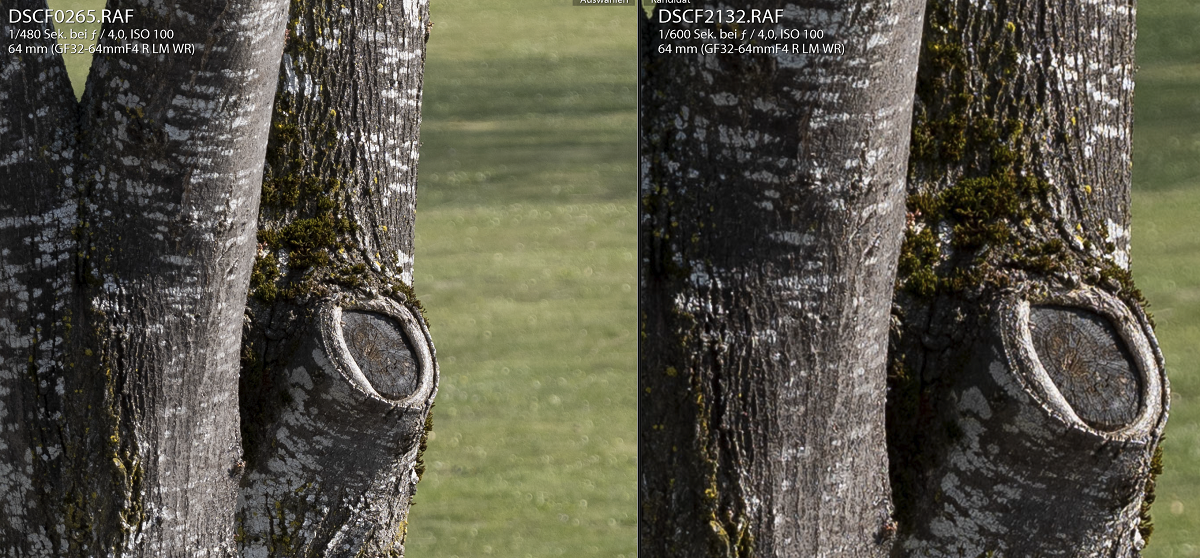
ORIGINAL SIGHT
Looking at the full-size image, you can see virtually no difference between the two FUJI's. It was a cloudless day, the pictures were taken one right after the other, at the same aperture, and yet the GFX 100 shot at shutter speed 1/480 (left picture) and the GFX 50R shot at 1/600 (right picture). As a result, the right image is a tad darker. I didn't compensate for this in Lightroom so as not to affect the out-of-camera RAW image.
From these two settings - in 1.1 and 2:1 crop, respectively - you can also see how violent the enlargement is at the top, how small the area is that is still shown here with excellent sharpness by both cameras.
More cropping is not necessary for me, in practice I have never needed such a crop.
So now here are the pictures in original size:
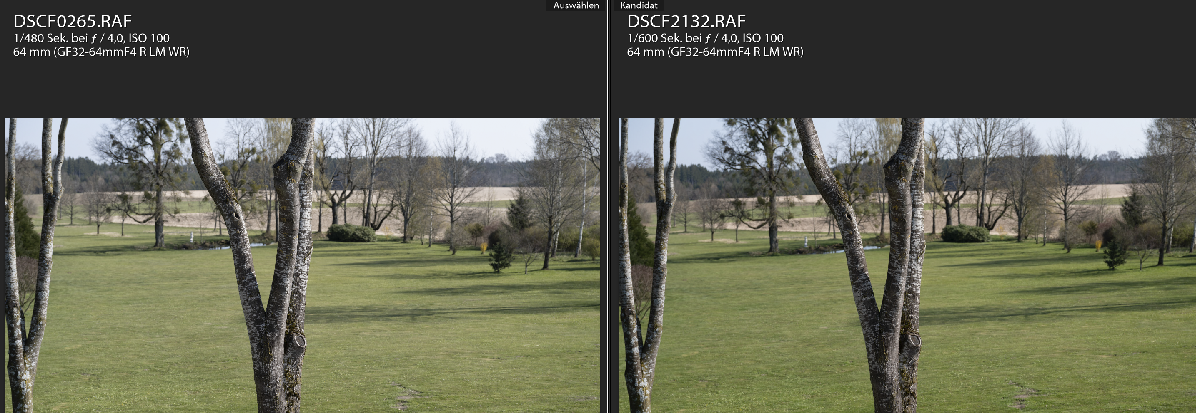
LEICA SL2 vs. FUJI GFX 50R
From here on, it's just about these two cameras - the LEICA always with the picture on the left, the Fuji on the right. The comparison to the NIKON Df (16MP) and the analog LEICAFLEX SL2 I will blog here later.
First the original view; unfortunately I forgot to set the FUJI to the same image format as the LEICA, hence the slightly different format. But does not matter for this comparison:
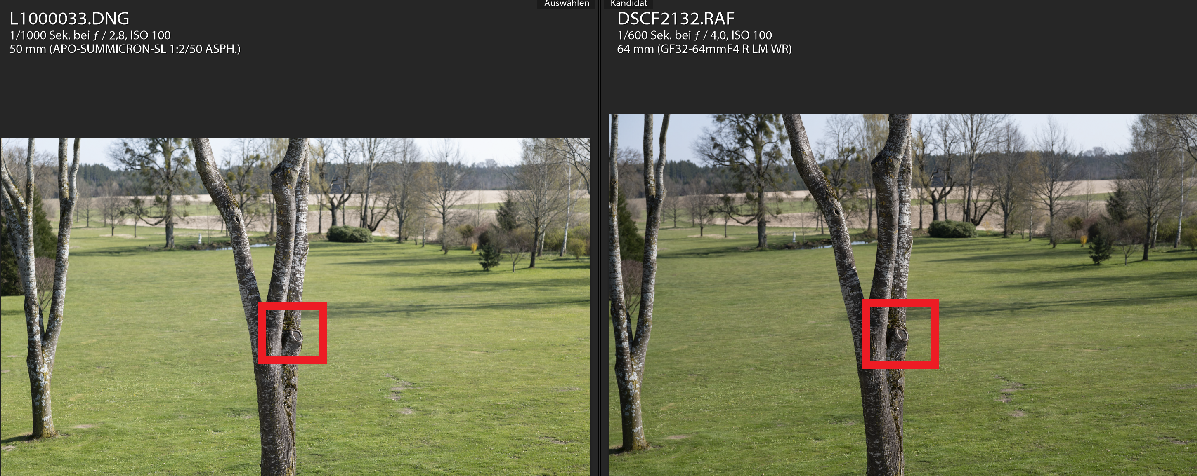
LEICA SL2 vs. FUJI GFX 50R
Here a 35mm format camera (LEICA SL2, left) competes against a medium format camera (FUJI GFX 50R, right). The FUJI has a ZOOM lens (GF 32-64mm f4), which I used because the GF63mm (35mm equivalent 50mm) does not have a good reputation in terms of quality - unlike this zoom.
When comparing the cameras, I was also more concerned with the sensors, the colors and the interpretation of light, the RAW's out-of-camera.
In the next chapter (2. TRANSPORTABILITY), under "Range around 50mm", it is explained exactly how and why the two lenses used here can be compared.
To my eye and my color perception, the LEICA interprets the image more lightly. The colors were also exactly those at the time of shooting, while the FUJI already saturates the colors more in RAW (!) and also adds more red.
Here the 2:1 Crop:
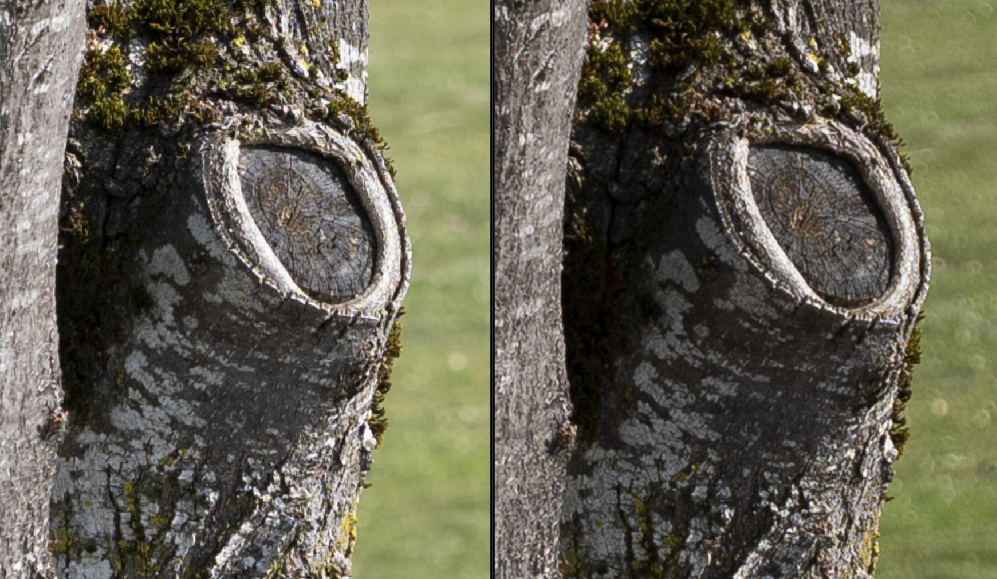
LEICA SL2 vs. FUJI GFX 50R
Now that is a matter of taste. Both cameras do an excellent job, which is after all a 2:1 crop!
When comparing, you have to take into account that the FUJI's 4MP higher resolution sensor makes it slightly larger, which gives it an advantage.
Here I cropped the image from the LEICA just a bit larger and darkened it by half an aperture (no further intervention!) - again, it looks better and more three-dimensional than the image from the FUJI:
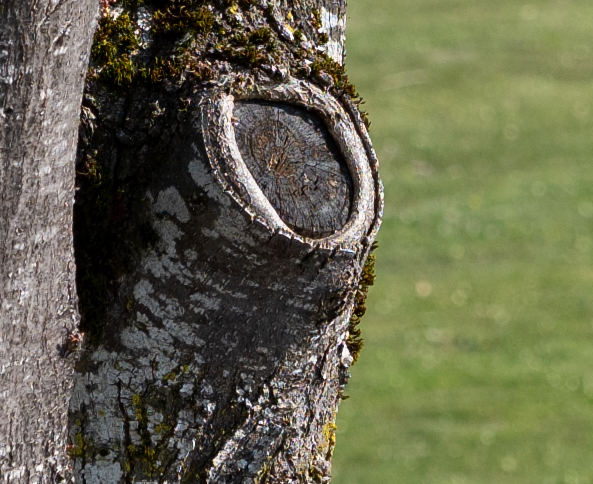
MYTHOS 3D & MEDIUM FORMAT
A medium format sensor does not automatically have a thinner plane of focus. The depth of field results from the aperture used.
However, when converting from medium to 35mm format, one must subtract a full f-stop from the aperture shown on the lens. The 64mm f4 of the FUJI lens is converted to 50mm f2.8 in 35mm format, but the aperture of f2.8 only refers to the depth of field - and not to the speed.
So if the FUJI lens has the depth of field equivalent to an aperture of f2.8, then the LEICA with its f2 lens has the thinner plane of focus. The only reason I had the LEICA imaged here with f2.8 is so that the faster lens cannot give the camera an advantage.
So the LEICA could have gained on the 3D effect. And it has a lens that transports a full two stops more light. And it is lighter and only half the size of the GF 63mm f4.
2. TRANSPORTABILITY
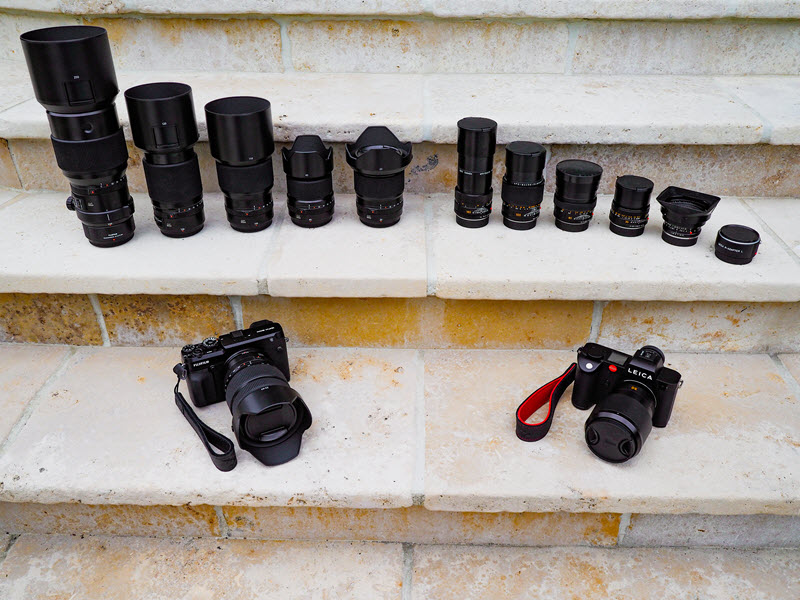
In this picture, on the left is the FUJI GFX 50R with the 32-64mm zoom and with another 5 lenses, and on the right is the LEICA SL2 with the 50mm APO-SUMMICRON-SL and with 5 lenses of the same or at least approximately the same focal length, plus a LEICA R to L adapter to operate the R lenses on the SL2.
The FUJI GF lenses are all autofocus, with the LEICA only the 50mm APO-SUMMICRON-SL that is on the camera. More on this later.
Note: On the 250mm FUJI (the lens on the far left) I accidentally left the 1.4 teleconverter on, this lens would be a bit shorter otherwise.
Since the sunshades on the FUJI lenses are disproportionately larger, here is the picture with the sunshades folded back on the FUJI lenses and the LEICA lenses with the sunshades pushed back on the body:
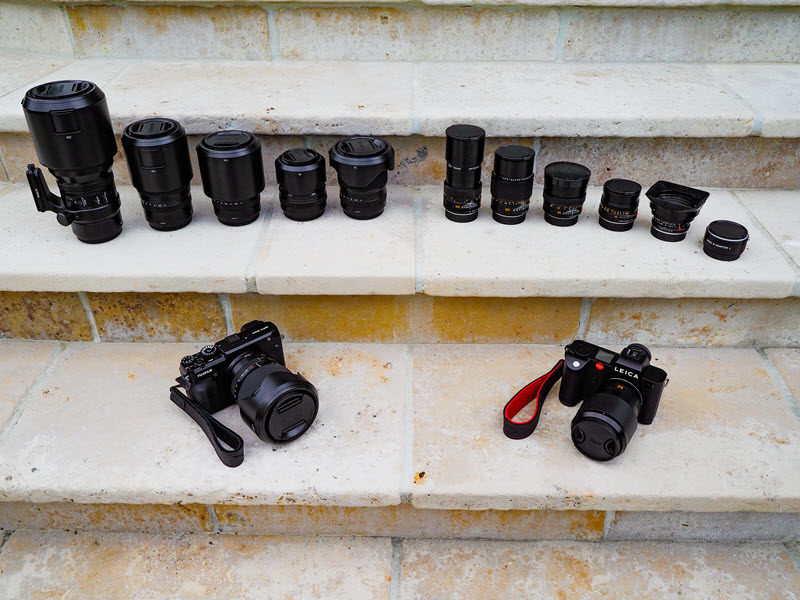
And here is the comparison lens for lens:
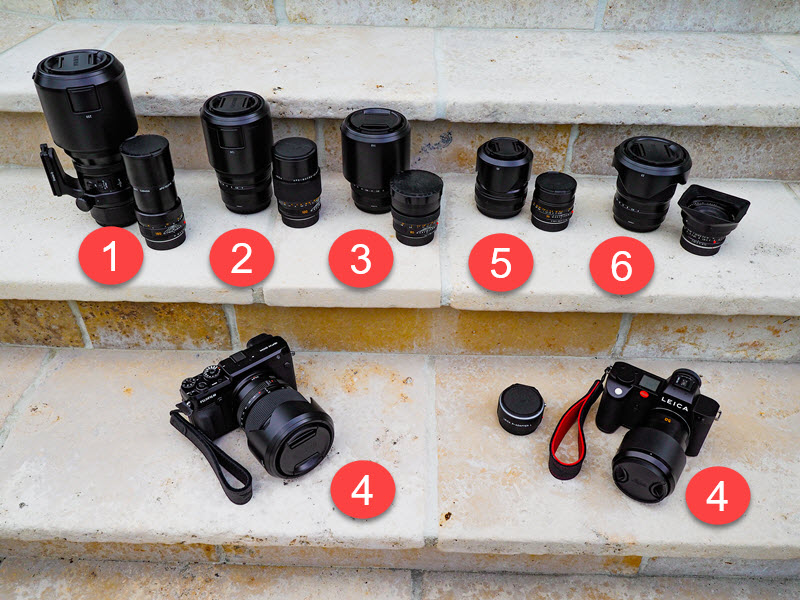
THE CROP-FACTOR
The FUJI lenses are medium format lenses, the LEICA lenses are 35mm format (also called full frame or 35mm). The designations of the FUJI lenses must therefore be converted to 35mm format (FUJI Roadmap with the conversion values). But that only applies to focal length and depth of field, not to speed. As is well known, this is independent of the sensor format. If this were not the case, you would have to use different light meters for each format.
1. RANGE around 200 mm
The FUJI 250mm f4 has a focal length of 198mm converted to full frame and a depth of field corresponding to f2.8. The LEICA 180mm APO-TELYT-R f3.4 has a slightly shorter focal length and half a stop less depth of field, but it is half a stop faster.
The FUJI 250mm has autofocus and is also very sharp at close range, while the LEICA 180mm APO-TELYT-R has its strengths in the range from twenty meters to infinity.
The size and weight speak for the LEICA lens here:
FUJI GF 250mm f4 = 1,425g and dimensions 108x204mm.
LEICA 180mm APO-TELYT-R f3.4 = 750g and dimensions 68x135mm
CONCLUSION
The FUJI 250mm is clearly the better lens at close range and has autofocus. However, I don't use my tele for close-up shots and will be happy to take the small LEICA tele (across brands, the smallest 180mm tele at at least this speed) with me in the future even if I have left the 250mm FUJI tele at home so far.
2. Range around 100 mm
The FUJI 120mm Macro f4 has a focal length of 95mm and a depth of field corresponding to f2.8 when converted to full frame. The LEICA 100mm Apo-Macro-Elmarit-R has slightly more focal length and the same depth of field, with one aperture more speed.
FUJI GF 120mm f4 = 980g and size 89x153mm
LEICA 100mm Apo-Macro-Elmarit-R f2.8 = 750g and size 73x104,5mm
CONCLUSION
I bought these lenses for their macro characteristics. For portraits and landscapes I have the FUJI GF 110mm f2 and the LEICA 90mm APO-SUMMICRON-SL f2. The lack of autofocus plays only a minor role for me in the macro range, so here too the LEICA lens is my favorite because of the dimensions and weight.
3. Range around 90 mm
The FUJI 110mm Macro f2 has a focal length of 87mm and a depth of field equivalent to f1.4 when converted to full frame. The LEICA 80mm SUMMILUX-R f1.4 has slightly less focal length and the same depth of field, with one aperture more speed.
FUJI GF 110mm f4 = 1.010g and size 94,3x125,5mm
LEICA 90mm SUMMILUX-R f1.4 = 700g and size 69x75
CONCLUSION
The 7mm difference in focal length is not important to me, but the difference in size and weight is. And this despite the fact that the LEICA SUMMILUX is one aperture faster. Because autofocus is important to me at this focal length, and because the LEICA 90mm APO-SUMMICRON-SL f2 is an APO lens of the latest design, I purchased this lens additionally (but have not yet received it because of delivery times). The FUJI 110mm f2 is an exceptionally good lens, even the new LEICA lens will have to fight to equal that.
4. Range around 50 mm
Here in the picture, my FUJI 32-64mm f4 is on the camera. But this is a zoom lens, so the comparison is lame. Actually, the GF 63mm f2.8 must be used for comparison here. I didn't buy this lens because it doesn't have a good reputation among experts - it's probably the weakest of the GF range.
The FUJI 63mm f2.8 has a focal length of 50mm converted to full frame and a depth of field corresponding to f2. The LEICA 50mm APO-SUMMICRON f2 thus has the same focal length and depth of field, with one aperture more speed. This LEICA lens also has autofocus.
FUJI GF 63mm f2.8 = 405g and size 84x71mm
LEICA 50mm APO-SUMMICRON-SL f2 = 740g and size 73x102mm.
CONCLUSION
This comparison goes to FUJI (!) in terms of weight and dimensions, image quality goes very clearly to LEICA.
5. Range around 35 mm
The FUJI 45mm f2.8 has a focal length of 36mm converted to full frame and a depth of field corresponding to f2. The LEICA 35mm SUMMICRON-R f2 has about the same focal length and the same depth of field, with one aperture more speed, but is a manual lens, without autofocus.
FUJI GF 45mm f2.8 = 490g and size 84x88mm
LEICA 35mm SUMMICRON-R f2 = 430g and size 66x54mm.
CONCLUSION
The FUJI lens wins this comparison. After the 110mm f4, this might be the second best GF lens. The LEICA lens is slightly lighter, smaller, one stop faster, but without autofocus. However, manual focusing is no problem at a focal length of 35mm, see here. My standard focal length is 50mm, I rarely need the 35mm lens, so I'm grateful if it doesn't take up much space in the camera bag.
6. Range around 20 mm
The FUJI 23mm f4 has a focal length of 18mm converted to full frame and a depth of field corresponding to f2.8. The LEICA 21mm SUPER-ANGULON f4 has a little more focal length (less wide angle) and less free focus (bokeh), with the same speed, but is a manual lens without autofocus.
FUJI GF 23mm f4 = 845g and size 90x103mm
LEICA 21mm SUPER-ANGULON f4 = 410g and size 78x43,5mm.
CONCLUSION
The LEICA lens is half the size and half the weight, with the same speed, but again without autofocus. Here, however, what was said above about the 35mm lens applies even more: Manual focusing is no problem with a focal range of 21mm. My standard focal length is 50mm, I rarely need the 21mm lens, so I'm grateful when it doesn't weigh much and doesn't take up much space in the camera bag.
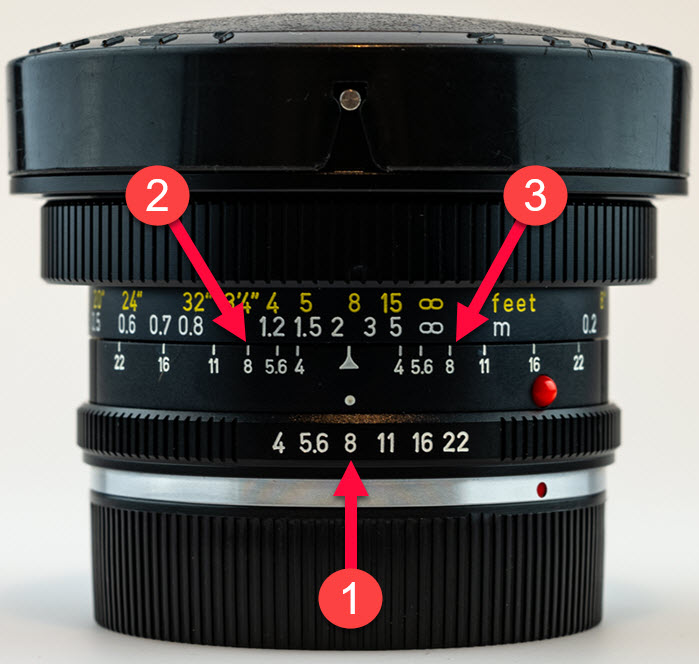
RANGE OF DEPTH OF FIELD
Here we have the manual focus only lens LEICA 21mm SUPER-ANGULON f4. The lack of autofocus doesn't play such a significant role for me with this lens for the following reason:
I take 90% of my shots in good light, and I adhere to the adage, "When the sun smiles, take (f-stop) eight." With this 21mm lens, that means that when I set f/8 (1) the depth of field reaches from 1,10m (2) to infinity (3).
So all I have to do is set the lens so that the infinity symbol is right in front of the selected aperture (in this case, aperture 8) and then I can forget about focusing - everything between the two 8 marks is now in focus.
THE LONGER THE FOCAL LENGTH . . .
. . . the shorter the range between the two 8 markings.
With this 35mm lens, the sharpness range does not start at 1.1m, as with the 21mm lens above, but only at 2.5m, if we want to set to infinity on the right.
When I do street photography, I don't need sharpness to infinity, 10 meters is enough for me. Turn the lens a little further and the focus range starts at less than 2m.
When I work this way, I no longer have to focus in the viewfinder, but simply beforehand on the lens.
At 50mm focal length and aperture 8, however, I only have the range 5m to infinity, which is where autofocus becomes more important.
If you want to know more about how to adjust the focus without looking through the viewfinder, directly on the lens, you can read about it in the Hyperfocal Distance section..
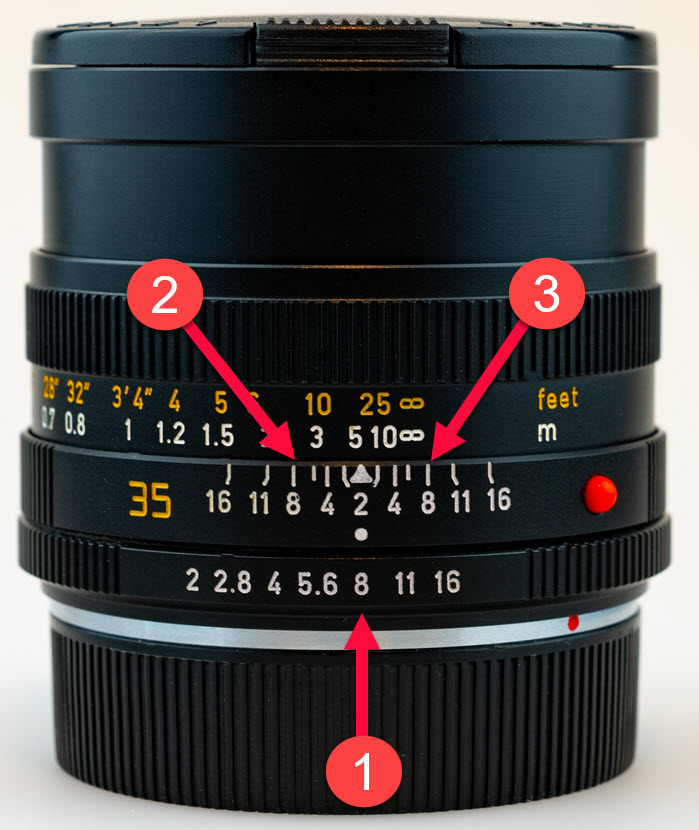
3. HANDLING & OPERATING
PRO
- Relatively small and lightweight, excellent (APO) lenses
- Camera lies well in the hand due to the large handle
- Simple menu, few buttons, focus on the essentials
- High-quality feel, workmanship and materials
- IBIS (stabilized sensor)
- Very good and inexpensive R-lenses (manual focus)
CONTRA
- No tilt screen
- High weight due to construction
- No dedicated dials with labels for aperture, shutter speed, ISO or exposure compensation
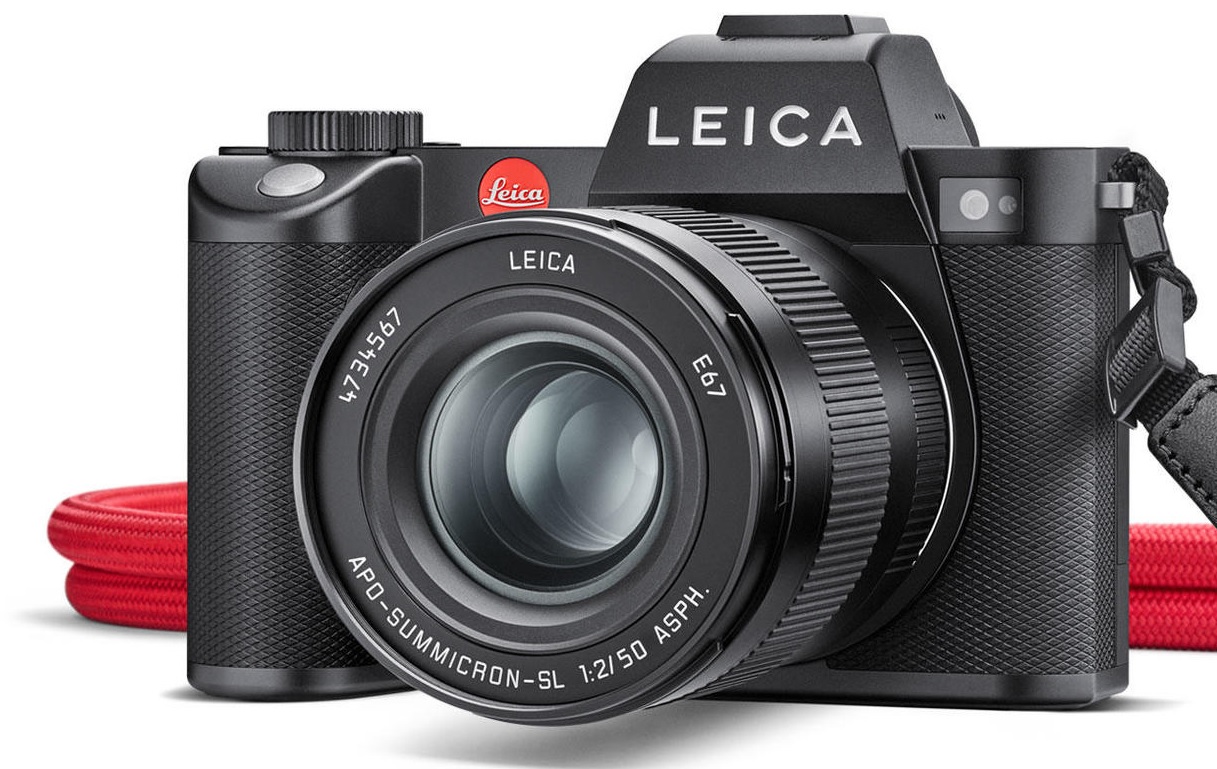
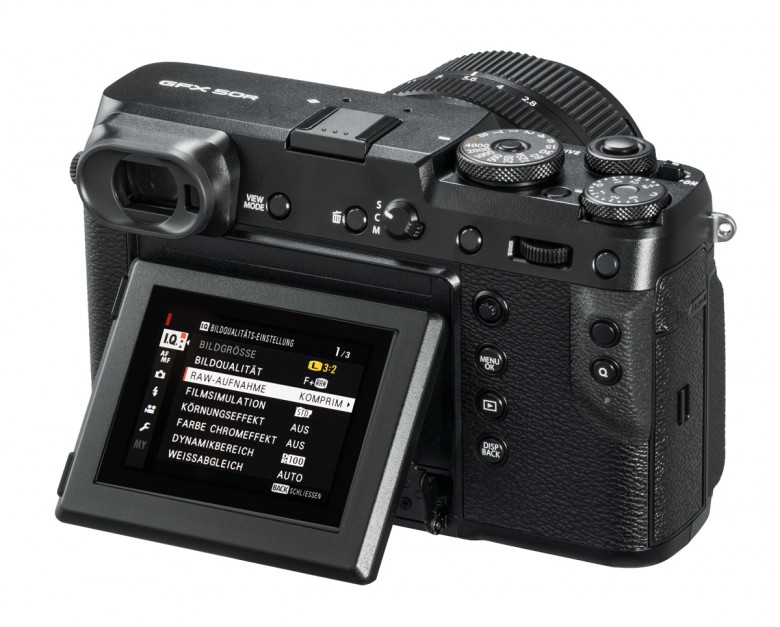
PRO
- High ISO values with little or no loss of quality
- Dials for aperture, shutter speed and exposure compensation
- Aperture can also be adjusted on the lens
- Tilt-Screen
- Relatively low acquisition value
CONTRA
- Very large and heavy lenses
- Flat handle, does not feel good in the hand
- Menu needs training
- No IBIS (stabilized sensor)
- Plastic haptic
- No top lens for my favorite focal length of 50mm
4. COMMON SENSE & EMOTIONS
ANALOG LEICAS
As described at the very beginning of this blog, after my CANON I had a PANASONIC G9, the OLYMPUS PEN F, the SONY A7 RIII, then the FUJI GFX 50S, then the 100 series FUJI GFX and finally the GFX 50R.
Multiple, sometimes chaotic and always highly complicated, deep menus that require a lot of training by studying the manual and YouTube tutorials and make it very difficult to switch from one camera to another if you have several at the same time. In the end, it was more about how to operate the cameras than about the photography itself.
It was in this state of menu fatigue that I encountered analog photography.

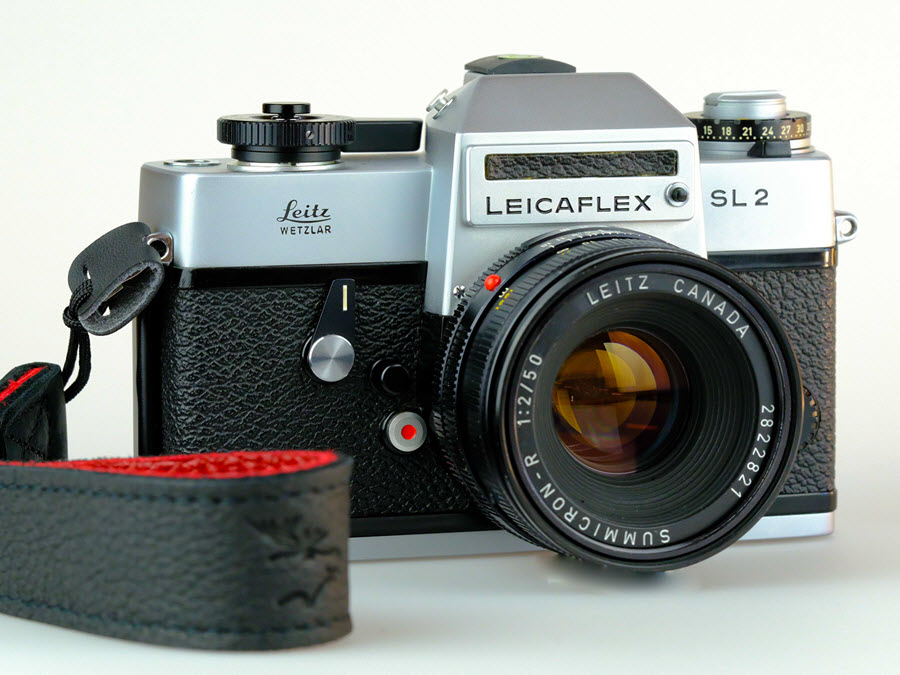
MY INITIATION
In the beginning, there was this LEICAFLEX SL2 camera.
What a peace of mind - finally no more menus, no more batteries, no more memory cards. Simply insert the film and shoot in peace. Carefully select the subject, set the aperture and shutter speed with the built-in light meter, check the composition, finally take another look at the focus - click!
And then wait until the 36th shot is "in the can," send in the film - and wait again until the film is developed and the digital prints and/or hard copies arrive.
No stress, lots of anticipation - photographing as it should be.
CONCLUSION
After my camera odyssey and the excursion into the analog LEICA and NIKON worlds, I then got my hands on the digital LEICA SL2.
There it was again: CLICK!
From my point of view, no other manufacturer of 35mm format cameras has saved so much purism and so much simplicity from the analogue world as LEICA.
There it is again, this calmness, this focus on the essentials, on taking pictures. In addition, there is this visual and haptic tangible value. And these incredible optics that LEICA has been producing for decades and that are built so sturdily that you can still take wonderful pictures with them after 50 years.
My odyssey is over - I'm home!

